Residential Exterior Doors – Your Complete Buying Guide
by Robert Fox
Choosing the right exterior door for your home can have many benefits, such as added security, conserving energy / saving money, and increasing the overall value of your home.
In fact, it wouldn't be an exaggeration to say that when people look at your home, the first thing they'll notice is the front exterior door, whether they be friends, family, neighbours, potential thieves, local mail delivery, and so on.
And so, some kind of assessment is made about you just from looking at your front door, among other things.
To put it another way, installing the wrong exterior door on your house (particularly your front door) is going to cost you in more ways than one.
That's why it stands to reason that any homeowner should take careful consideration before purchasing an exterior door, especially if it is your first time doing so.
For starters, keep in mind that an exterior door doesn't just refer to your front door, it can be any door that leads in/out of your home. So, not only are we referring to front doors, but also side doors, garage doors, patio doors, back doors, basement doors, etc.
Contents
- Standard Exterior Door Sizes
- Slab Or Prehung Door?
- Exterior Door Installation
- Inswing Or Outswing Doors
- Energy Conservation / Weatherstripping
- R-Value
- Exterior Door Materials
- Steel Exterior Doors
- Steel Door Design
- Painting A Steel Door
- Steel Door Benefits
- Gauge Of Steel
- Why Not A Steel Exterior Door?
- Residential Wooden Exterior Doors
- Best Wood For An Exterior Door
- Wooden Door Materials
- Pros And Cons Of Residential Wooden Exterior Doors (Quick List)
- *Pro-Tip*
- Textured Fiberglass Exterior Doors
- Why Exterior Doors Are The Best Overall Choice
- Fiberglass Doors Provide Security
- Fiberglass
- Best Place To Buy Residential Exterior Fiberglass Doors Online
- Best Place To Buy French Doors Doors Online
- Types Of Glass For Exterior Doors
- Related posts
Let's dive in!
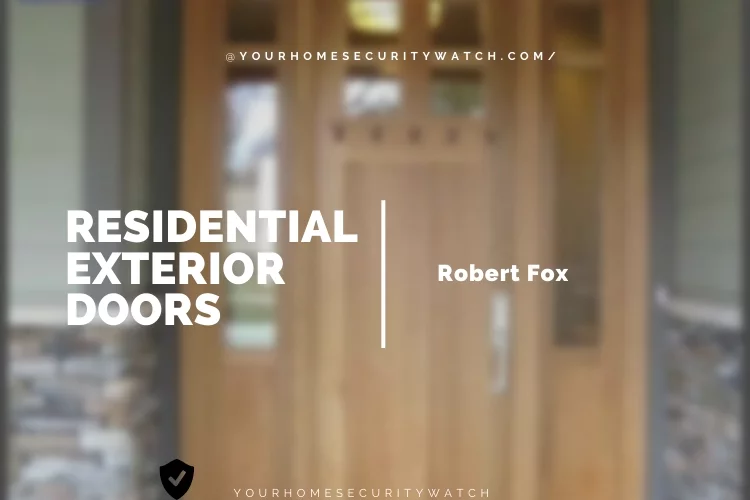
Standard Exterior Door Sizes
Lets begin with talking about standard sizes for exterior doors.
When speaking about standard sizes, we spoke with the fine folks at Moulding Bin in Bakersfield, California. They have been in operation since 1983 and have seen a lot of doors, that's for sure. Here's what they said when it comes to standard door sizes.
"One common misconception is that doors are standard."
Looking at a few homes you might notice a pattern, but overall there can be a multitude of variations of size especially on older homes. Exterior Doors come 30″, 32″, and 36″ commonly. Entry doors most often are 36″ doors, but with Fiberglass and Residential metal they now come 35-3/4″x79″. In this industry we encounter metal and fiberglass coming into our shop at 35-1/2″.
When we see this most often what has happened is the wood styles that come out the edge of the door have been cut off to accommodate the frame. This voids your door's warranty and we do not recommend it. Framers set the tone for what size the prehung doors need to be and as with anything that involves human errors can be made. This is why we see doors at random measurements and why from my seat there is no standard. Side doors and back doors tend to be in the 30″-32″ range with the same -1/4″ width and 1″ height for metal and fiberglass.
Double doors are fun because of the availability of certain styles in different sizes. Six foot double doors (each door at 36″) have no restrictions because all exterior doors are produced in 36″. Five foot double doors (each door at 30″) see a drop in availability, but companies are starting to produce more options. For the not so lucky 74″ double door client, there are even less options but, of all the double door units these are the most uncommon. It is always good to get precise measurements of your existing doors width, height, and thickness before shopping around." Basically, there are standards, but nothing in the door business is absolute, so you can't be too careful when it comes to measurements.
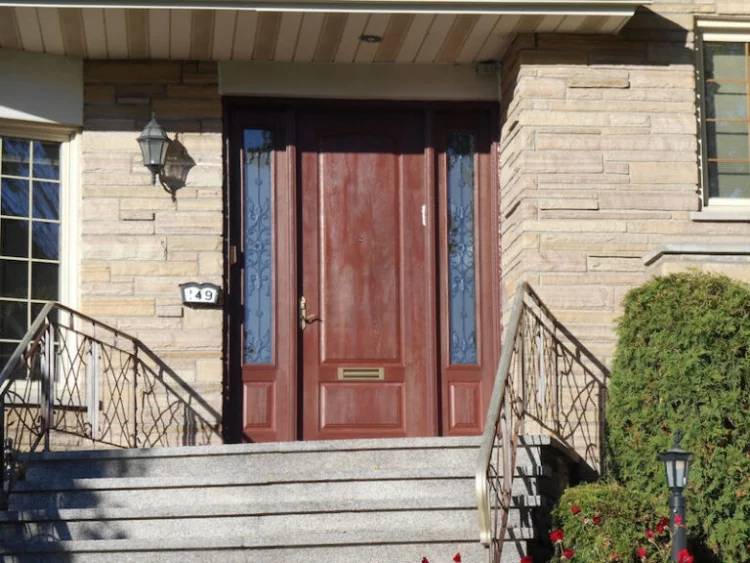
It's probably a good idea to enlist in the assistance of a specialist, unless you're intent on learning a whole lot about doors before your mission is done.
Slab Or Prehung Door?
There's two basic options for when you buy a new exterior door - slab or prehung.
If you choose to go with getting a slab, remember, its just that - a slab with nothing done to it (most commonly a slab of wood). This option can be good for those who are fairly handy and have that DIY mentality. Its also substantially cheaper than the other option, which is a prehung door. While it is more expensive, a prehung door is what we recommend in most cases to anyone who doesn't want to do a lot of labor in installing a new door. Prehung doors come complete with everything you need pre-assembled and ready to install - the frame, the hinges, and the door. This includes most of the precision work done beforehand.
This option, although more expensive than purchasing only the slab, eliminates the possibility of error that often occurs when installing a door yourself.
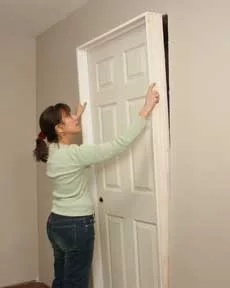
Exterior Door Installation
If you go with the slab, installing it can potentially cause a lot of frustration if you don't know what you're doing.
With prehung doors, installation is a lot simpler, so unless you enjoy being handy, or want to learn a whole new skillset entirely, we think a prehung door is the way to go.
Your average homeowner might not have the time required to do a handyman's job.
Still, with a prehung door, there is a fair bit of work to do just to get it installed, although it is a lot more manageable.
Even a non-handy-person could get that job done in about an hour, provided they've got the right tools for the job.
Here is a video from the folks at Lowes, which will show you how to install a prehung door.
This should give you an idea of what you're up against if you choose to install it yourself.
Many people simply hire a professional to do the job, which is going to cost you a few hundred dollars extra to have a pro put it in, but the alternative to that is *you* putting it in.
Check out the video and see what you think…are you up for the challenge?
Up next…Inswing vs. Outswing Doors.
Inswing Or Outswing Doors
This is a concept that a lot of folks don't think about right away when it comes to their exterior doors and there's more to it than you might think.
In a nutshell, we're just talking about whether a door swings inward or outward. This is, of course, something which is predetermined when the door is made, with inswing being the more popular of the two swing styles.
The difference between an in and and outswinging exterior door should not be underestimated.
It can mean the difference between having a more secure home or a less secure home, and it also affects things like maintenance, and ultimately, your wallet (so its worth understanding).
Here is a quick video which has an easy-to-remember method for telling the difference between whether a door is an inswing or an outswing.
As far as the nitty gritty for purchasing a door which is inswing or outswing, we like to refer people to this great article on the topic, which does a great job of explaining the concept of inswing vs. outswing.
Energy Conservation / Weatherstripping
Obviously, conserving energy in our home is always going to save us money.
You've probably said or at least heard someone say, "Are you trying to heat the great outdoors?" when someone leaves a door or window open by accident, allowing all the heat to escape outside.
So, of course, we know that having an exterior door (one that connects inside with outside) that closes firmly and minimizes heat from escaping in the winter, or keeps the heat out in the summer - is ideal.
Because a door is not a stationary object (it moves), one important consideration for our exterior doors is weatherstripping.
Weatherstripping is when we seal the cracks and spaces around our door to prevent air leakage, often with special foam tape, like this popular tape from the company MD.
A properly weatherstripped door will keep your utility bill down.
Prehung doors usually come complete with weatherstripping, but in other cases, you have to do it yourself. If this is the case, you'll need the following tools (as the video explains):
- Work Gloves
- Power Drill
- Tin Snips
- Measuring Tape
- Pry Bar (if replacing old weatherstripping)
- Hammer (if replacing old weatherstripping)
It's not difficult by any means, but the point is that the better job you do of getting that snug fit with your weatherstripping tape, the less leakage you'll have, and the more insulation you'll add to your entryway.
Weatherstripping is something any homeowner should understand when it comes to their exterior door, as it is the best way to provide insulation aside from the door itself.
R-Value
When it comes to doors and how well they insulate your home (and hence save you money), their "R-Value" is without a doubt a very important consideration.
Basically, R-Value comes into play when we talk about thermal resistance, or simply what a door is made from, and what is inside that door that is being used for insulation purposes.
On the surface, the higher the R-Value, the better insulated your door will be as heat won't escape as easily.
We should also note that overall, R-Value is a broad term and isn't just a term applied only to doors.
So, when you are in a store shopping for a door, it will likely not be listed as a selling feature for that particular door. Nonetheless, we feel it is an important concept to understand before buying a door.
Take a quick look at this page on the Therma Tru website, which mentions R-Value.
Therma Tru are one of the leading door manufacturers in the United States, and you can see that what they've done here is provided an information page which talks about concepts like R-Value, just to give customers a better understanding of the idea, as opposed to putting an individual R-Value on each of their products.
That said, if you were to speak to a representative at Therma Tru, or any leading manufacturer, they will of course be able to discuss R-Value with you, and how it applies to any door you might be interested in.
Now before we assume that R-Value is the only factor when judging the insulation a material provides, hold on, because R-Value is only one of four factors that affect insulation overall.
Those factors include:
- preventing heat loss due to conduction
- preventing heat loss due to convection
- preventing heat loss due to infiltration
- preventing heat loss due to radiation
We need to understand that R-Value gets assigned to insulation materials in a lab, and of course, our homes are outside facing the elements every single day.
This is a very dynamic relationship and can't be easily summed up by slapping a value on any of your doors, and thinking that's the end of the story.
Regardless of how well-built and solid your exterior door seems, all doors need to breath on some level.
Because there are small gaps everywhere on our home, R-Value doesn't always behave as we might expect.
However, without getting too scientific, determining a doors' R-Value does provide us with a basic idea of how well insulated it is, and that is, of course, worth knowing.
Exterior Door Materials
What are the main materials exterior doors are made of?
This is not exactly a mystery to most of us. Surely you've seen all sorts of doors in your life, from different kinds of metal, to fiberglass, to various types of solid wood, and so on.
If you are not an exterior door expert, you might hold certain assumptions about these types of doors that may not be true.
For instance, you might be wondering if a steel door is appropriate for residential use, since we sometimes associate them with factories and labs.
Can a wooden door stand up to extreme weather?
Maybe you've heard fiberglass is the best residential exterior door material.
There are many questions we might have when we are looking for a new or replacement exterior door, and in this section we hope to shed some light on each type of material.
In the interest of getting the best value for our dollar, we must ask ourselves - what are the pros and cons of each of these materials? Are they all appropriate for residential use?
Some of the answers may surprise you, since exterior doors may not be what they seem upon closer inspection.
Hopefully we can blow up a few myths regarding exterior doors right here. Read on to get the answers…
Steel Exterior Doors
The first thing to mention about steel doors is that times sure have changed!
It wasn't long ago that exterior steel doors were in fact not very stylish, which is why they've gotten a reputation for being used where people wouldn't really see them, like industrial areas where they could provide some extra security at the backs of buildings, or you might see a steel door in some 80's action movie, located in some dark alleyway.
To be blunt, steel doors used to be ugly, and not suitable for homes where they would be plainly visible.
In recent times, however, door manufacturers have upped their game, making steel exterior doors to look just as inviting as their wooden counterparts, which is a great thing, because it brings the security steel provides into any residential setting.
Steel Door Design
When it comes to steel exterior door design, manufacturers are able to achieve basically any look and style that they can with wooden doors.
Whether its a two-panel look, four panels, or any beautiful detail work we normally associate with wooden doors, such as arches, flowing lines, or the inclusion of intricate glass - steel doors can do it all these days!
In most cases, you will be looking at a selection of doors with various patterns at your local home store, and you will notice that many of them aren't painted, although they will come galvanized (to prevent rusting and corrosion) and primed (ready to paint).
Part of the reason that a modern steel exterior door can be just as attractive as any wooden exterior door is that in addition to being able to capture intricate details in the design work, there are several different options for how to paint your steel door, which can make all the difference in terms of how inviting or attractive your door is.
For instance, want to make your door look like its made from wood? Here's a great article that talks about how to do that.
Painting A Steel Door
Although painting a door can be a tedious task, the main advantage of doing it ourselves allows us the chance to completely customize the look of our exterior door in terms of color, texture, and overall appearance.
This is why choosing the right type of paint, not to mention the right color, is so important if that's the route you'll be taking, because it can mean the difference between a door that looks awesome, and compliments your home, and one that well…doesn't.
Did you know that certain types of paint can provide extra weather-resistance and insulation?
If you do some research, you can find a paint or finish that will not only make your exterior door look great, but can add value to your home in other ways as well.
Here's a quick video about how to paint a steel exterior door:
Steel Door Benefits
Aside from the look of your steel exterior door, there are a lot of other benefits to having a door made out of steel, such as security and durability.
When it comes to having a secure exterior door, steel is at the top of the list of materials.
Check out this video which shows the "world's most secure door", by a Turkish company called Sur.
While not all steel exterior doors will offer the level of fortification seen in this video, steel doors as a rule are generally tougher than fiberglass or wood.
So, in terms of stopping intruders, steel doors will do the job better than most, provided that everything around the door is just as secure, including the frame, jamb, and hinges.
Long 3″ screws to strategically hold things together and a sturdy deadbolt are recommended, or else those potential weak points will defeat the purpose of having a strong steel door in the first place.
Granted, you probably won't ever have to deal with two large gentlemen trying to knock out your front door with a battering ram, but in the event that someone does attempt to kick in your exterior door (unfortunately a fairly common experience), having a steel door does have its advantages over other materials.
This may be obvious to some, but let's say it anyway - steel doors are not made entirely from steel. If they were, they would be much too heavy to use in a residential setting.
Most steel doors contain an inner frame made from wood, or possibly steel for extra security. Then, they are filled in with high density polyurethane foam.
As we mentioned before, steel doors can take on a number of different appearances depending on the paint job or finish.
The door to the left from Palace Home Decor is a good example of a steel door, which has a beautiful wooden appearance while still being made from steel.
Gauge Of Steel
When it comes to steel, you may be familiar with the term "gauge". With regards to the gauge of steel, the higher the number, the thinner the steel.
When you're at your local home store, you will be seeing a lot of steel doors with a gauge of 24, but don't expect that to provide you with a lasting solution.
24-gauge steel doors are not very thick, and are liable to rust and chip in no time. This gauge is also quite bendable, especially when it's just one layer of thin steel and insulation.
With steel exterior doors, we feel the ideal gauge to look for would be 22. When it comes to a lasting home solution which will easily take paint, simulate different textures, and provide a high level of security, this is the gauge to go with.
You can get thicker gauges of steel, but they are not really appropriate for a residence, rather for commercial purposes.
If you want to really get into the nitty gritty of steel, here is a document which will make your head spin, but contains a lot of useful technical information.
Why Not A Steel Exterior Door?
While steel exterior doors do provide a low maintenance, energy efficient, cost effective option when choosing a door, there are a couple of concerns we think are worth mentioning.
If you are shopping for an exterior door with a curved or arched top, these kinds of designs can not be achieved with steel.
This could be considered one of the major limitations of going with steel. While there are a wide variety of designs to choose from, some of the shapes that are achievable with wood are not possible with steel. Bummer.
Another reason that some people won't go with steel for an exterior door is because their home has a very specific look.
Say, for instance, your home has a lot of genuine wood in it, and you are looking for a steel door that simulates that look in order to match with either the inside or outside of your home.
While steel can get pretty close to simulating authentic wood grain, it is not authentic, and when it comes down to it, you can tell.
Because getting the right match style-wise between your door and your home is so important, you'll want to make sure that you give it some consideration before buying a faux wood (steel) door to match the rest of your home.
In in some cases, faux wood can do the job, but not always. Just something to think about.
Overall, steel exterior doors have a lot going for them. They're weather-resistant, durable, secure, affordable, and come in a variety of styles and colors.
They might be just perfect for your home, but we have several other doors we want to talk about and we hope you'll read about them as well.
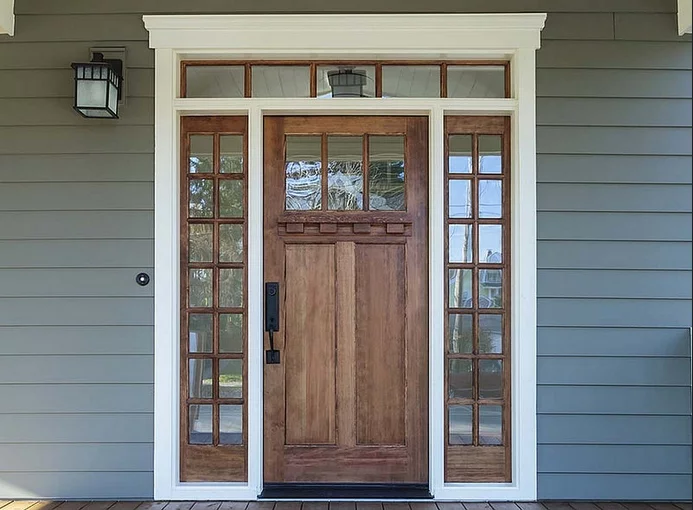
Residential Wooden Exterior Doors
Wood is the most popular material from which exterior doors are made, and also the oldest material for constructing what we might consider an actual door (eg. swinging open on hinges) in the historical sense. Click here for proof of this claim.
Wooden doors are known for their charm, and providing a unique look for your home. Since each tree is so unique, they provide doors with a similar uniqueness which is at the same time very natural and warm.
This cannot be said for materials like steel or fiberglass.
In terms of all time classics, wooden doors are the go-to choice for homeowners, based in part on their aesthetic appeal.
A nice new well-made wooden exterior door on your home is something of unmatched beauty to behold (yes, we do love our wooden doors very much).
Best Wood For An Exterior Door
In general, there is a long list of wood species that are used for doors, but when it comes to exterior doors, not every wood is most suitable. Here is a short list of what we consider the best types of wood for exterior doors:
White Oak
White Oak is one of the best types of wood to use for an exterior door.
Why? Because it can be purchased in a variety of colors, including: clear, fruitwood, autumn oak, wheat, cherry, dark oak, dark walnut, and more.
The example to the left is from O'Donnell Woodworking ( click to visit their site), which offers a wide variety of selections of White Oak exterior doors.
Because White Oak is naturally highly resistant to decay and moisture due to its tight grain pattern, it makes a great choice for an exterior door, since it can stand up to the elements.
Also, it is quite heavy, making it very secure and giving it a nice heavy swing when opened or closed.
White Oak as a building material is also quite popular, as it is very versatile and used worldwide in a number of different industries.
Mahogany
Another great type of wood for exterior doors is mahogany. Why? Because, similar to white oak, mahogany is resistant to moisture, making it a prime candidate for facing the elements on a daily basis.
In addition, it has a naturally beautiful, rich look (we are in agreement with
on this point), featuring very deep, warm tones (although the sapwood can be much paler).The grain structure is interlocking or straight, giving mahogany a somewhat striped look. Personally, it is our favorite exterior door material because it adds an almost exotic look to your door, and looks particularly great when finish is applied.
The door to the right is from Illingworth Millwork, which you can visit by clicking here. They have a wide selection of exterior doors, including many done in mahogany.
Check out this video slideshow of some great mahogany doors, which also shows just how versatile mahogany can be as a building material. Some of these exterior door designs are quite amazing, with some very appealing and sensuous curves:
Pine
While some types of wood don't exactly announce their wood-iness to the world, pine is a wood that is full of knots and details which basically says: "Yes, this is unmistakably wood you're looking at!"
This is why pine, as a building material, is preferred if the builder is going for that rustic, colonial, old-fashioned look. Not only that, we feel that in some cases pine almost has a feeling which we can only describe as…epic.
Make no mistake though. Although pine is full of what could be considered inconsistencies, the wood is strong, which is why builders use pine to build things like cabins, furniture, and, of course, exterior doors.
Earlier we talked about how a wooden door gives a home a unique look. This could not be more true with a pine door, which, as a building material, is simply very distinctive looking.
The door on the left is supplied by Pine-Door.com, which specializes in many quality exterior doors including many excellent doors made from pine.
Here's a quick look at what a pine door looks like. While this one is an interior door, you can see how good pine is capable of looking:
Wooden Door Materials - Honorable Mentions
Here we've listed three types of wood that we think look great for exterior doors - pine, mahogany, and white oak. We would be remiss if we did not at least mention a few other types of wood that are used to build exterior doors, including:
Cherry
Cherry wooden doors have a very distinctive look because of their color, which ranges from deep red to a reddish brown, with occasional blonde streaks visible.
This wood is perfectly suited for exterior doors, due to its color, warmth, and its ability to stain well.
Hemlock Fir
Known for its almost creamy appearance, hemlock also sometimes contains hints of red and lavender, particularly around the knots and in the areas where spring and summer growth rings occur.
Hemlock is fine in texture and straight-grained in appearance. Over time, it stays true to its original pastel color and it also takes paint and stain very well.
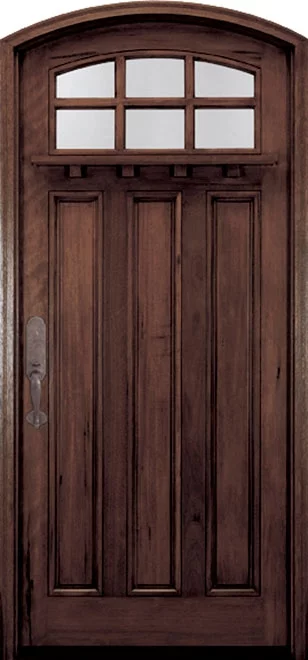
Walnut
You'll find walnut used on things like boats and furniture, but also exterior doors, where it is one of the more expensive species of wood.
The color variances in walnut are also very distinctive, from dark brown to almost a purple-black. It is straight grained, with visible waves or curls.
When finished, walnut exterior doors require a grain filler.
Pros And Cons Of Residential Wooden Exterior Doors (Quick List)
As you can tell from some of the wooden exterior doors above, wood is a material that is perhaps impossible to fully replicate, although some steel exterior doors do an admirable job of trying.
Now we'd like to talk about a few of the pros and cons that go with wooden exterior doors, in the form of two quick lists:
Pros
- Naturally beautiful, warm-looking, and always welcoming
- Most versatile in terms of design, with many custom possibilities
- Unique, one-of-a-kind, eye-catching
- Many different types/species of wood to choose from
- Easy to repair scratches and dings
Cons
- Generally more costly than other materials (although you get what you pay for in most cases)
- Absorbs more moisture than a metal door
- Requires regular maintenance
- Tendency towards warping, peeling, bowing (especially with poorer quality woods)
- Style over security
*Pro-Tip*
If you are thinking that a wooden exterior door might be the right choice for you, consider this: A wooden door will require less maintenance if it is underneath an overhang, which will partly shield it from the elements and the sun.
Since many of the issues with wooden doors, such is warping and fading, are due to direct exposure to natural forces (wind, rain, sunlight, snow, etc.), having your wooden door placed in an area where there is some protection will increase the lifespan of your door substantially.
Textured Fiberglass Exterior Doors
Textured fiberglass doors are starting to surpass most other types of doors as being the top choice for homeowners nowadays.
Why? Well, as we mentioned earlier in regards to steel doors, door manufacturers are getting more adept at making doors that are not wood look a lot like wood.
This is true for steel doors, but it is more so true for textured fiberglass doors, which are able to mimic the details found in wood with much more accuracy than steel exterior doors.
And that's saying something, because many steel doors do actually look very similar real wood. Textured fiberglass just takes it to a whole other level.
If you've ever heard of Accugrain, which is a relatively new technology pioneered by Therma-Tru, you can see how close some companies can come to making realistic looking faux wood doors that would fool even some pros.
Why Exterior Doors Are The Best Overall Choice
Other positive characteristics of fiberglass when it comes to exterior doors is the fact that, unlike wood, are not at all susceptible to rot, mold, and deterioration.
Fiberglass doors are like super doors, and basically immune to most of the problems that plague their wooden counterparts.
As such, the maintenance on fiberglass exterior doors is usually very low, and in terms of cleaning, they require mainly just soap and water to do the job.
If you're looking for a door that will last and last, fiberglass is right up there at the top, providing excellent value for the money you'll spend.
During the winter, fiberglass is great at keeping the cold out, and, conversely, it is also great in the summer for keeping the cool air in.
Speaking of the changing seasons, when it comes to weather, fiberglass practically yawns at Mother Nature's attempts to beat it down with wind, rain, snow, etc.
Although they are not impervious to damage, fiberglass doors are great at resisting dents, scratches, and rust - more so than steel.
Fiberglass is basically the opposite of wood in some ways. It is a fairly new invention, dating back to the second World War.
If fiberglass seems rather unnatural, that's because it is more of a modern product and requires a long multi-step procedure to produce it, although in a sense it is no more unnatural than steel.
That said, fiberglass exterior doors succeed in many ways that wooden doors fail, being such an energy efficient building material.
That, and fiberglass doors have the uncanny ability to look just like wood, as we mentioned before. If only wood could speak, it might say that fiberglass has a very unfair advantage here in the door industry, acting like a chameleon.
In actual fact, fiberglass doors do have wooden parts, such as their stiles and rails, which are attached to the molded fiberglass skins, and then filled with the polyurethane foam.
Have a look at this video which talks about the history of fiberglass and how it is made. Very informative.
Fiberglass Doors Provide Security
As far as home security, fiberglass is quite strong, and is akin to steel in its ability to resist an intruder trying to forcibly knock down your door.
Since it is not wood, it doesn't behave like wood when its taking a pounding, and isn't as weak when it comes to withstanding the potential array of brute force weapons like people's bodies (shoulders, feet), sledgehammers (how rude), and battering rams (remember our large friends from Sur?).
Again, here is where we underline that in most cases the weak point of entry for an exterior door would not be the door itself but rather the hinges, the frame, the deadbolt, or the windows (we'll get into glass later).
Take a look at this handy chart (below) featuring the top three exterior door building materials, provided by our friends at Therma Tru (leading door manufacturers), and you will see that they also say that fiberglass doors are perhaps the best all around choice for your residential exterior door, since they have no real weak points overall.
Fiberglass - The Ultimate Exterior Door Material With But One Caveat
We would like to add one caveat when it comes to fiberglass exterior doors, which is that you can't skimp on them in terms of what you'll pay.
As such, expect to pay no small amount of money for a decent (if not exceptional) fiberglass door.
Since these doors start at around $200, don't expect to see a marked difference in value until you get to about $500, or even $1000 in price.
Cheaper brands of fiberglass doors do exist and they are liable to crack or even fall apart on you before long, so beware.
Best Place To Buy Residential Exterior Fiberglass Doors Online
French Doors
French doors are mostly known for the elegance and the classic look they provide. They are perhaps the most elegant doors ever.
These exterior doors are constructed by several glass panels that are surrounded by a frame.
These exterior doors are actually covered with these panels for the most part, and they open from the middle.
There is a selection you can make concerning the glass type used for these panels, which can be clear glass, or stained glass mosaics.
These panels can actually be installed in several different ways:
- singly
- in pairs that match
- as series
There is also an option when it comes to the material used for this type of exterior doors. Besides wood, metal, fiberglass as well as composite can all be used to produce these beautiful doors.
The main benefit of having French Doors, besides the look of the door itself, is the view it provides.
If you have a nice-looking garden, or anything else that you like to look at, French Doors really connect the space between inside and outside in a simple, classic way.
Moreover, your home will never lack sufficient light, which is another great thing about French Doors.
To their detriment, French Doors are perhaps the least secure of all doors, which is something we all must consider before buying.
The sad fact of the matter is that if you have a great view looking in or out of your home, so does any potential intruder.
Not only that, but they are less energy efficient, and less secure than other doors.
This is why you should carefully consider your French Door purchase, examining closely the quality of glass, level of insulation, and type of locking mechanism it provides.
Best Place To Buy French Doors Doors Online
Craftsman Style Doors
One of the kinds of residential exterior door that never seems to go out of style is the Craftsman style door.
This style of door harkens back to what's called the Arts & Crafts movement, which started in England, and then swept through Europe and North America around the turn of the last century.
Who knew "Arts & Crafts" was an actual artistic movement?
The characteristics that define this style of door is that of romanticism, old-fashioned craftsmanship, and folk-based forms of expression.
There's even a hint of anti-industrialism that stems from this movement. Wow, who would have thought a door could really "say" something?
Generally speaking, this style of door is defined by real wood and known for its decorative beauty.
Also, in general, you'll find these kinds of doors attached to houses which are characterized by their attention to detail, as well as their use of stone, hardwood, and natural materials.
You'll also see a lot of overhanging eaves on these homes, as well as low-pitched roofs, and visible support beams and rafters.
Types Of Glass For Exterior Doors
We have yet to talk about one of the most common things you'll see as part of an exterior door, and that is glass.
There are a number of different types of glass you will see featured in exterior doors, and here is a quick list of some of the most common types:
Clear Glass
One might say that clear glass is the most common type of glass you'll see on an exterior door, and it certainly has both its pros and its cons.
Starting with the bad news first, clear glass allows anyone to see into your home, lowering the security level of this glass right away.
If clear glass has been installed on some French Doors, as seen above, we are talking about some of the lowest security a exterior set of doors can provide since French Doors with clear glass, while it does look very nice, isn't hard for an intruder to break into.
On the upside, clear glass lets in a lot of light and does look beautiful. Also, just because glass is clear doesn't mean it can't be reinforced, or toughened (as you will read more about below).
Most doors with impact resistant, insulated glass are also transparent, so don't assume that clear glass is necessarily weak.
Textured Glass
Textured glass can include frosted glass, water glass (pictured above), beveled glass, and a variety of other textures which can enhance the look of your exterior door.
One of the great things about textured glass is that it can provide security for your home in the sense that you can't see inside, while at the same time adding a unique and decorative touch to your home by way of the texture you choose.
As you can see in the example above, this water glass does a good job of obscuring what is inside your home, while offering a unique look that most doors won't have.
On the other hand, textured glass doesn't usually add any extra security or energy efficiency.
Insulated Glass
Also known as double-pane (or triple-pane) glass, insulated glass for your exterior door is designed to be more energy efficient, and so also more cost effective.
On top of that, insulated glass is more secure due to the number of panes used, which will be two or more.
The way insulated glass works is that basically that it better controls the transfer of heat or cold between the two panes of glass, which will affect the temperature of your home overall.
Low-E glass should also be mentioned here (which refers to low emissivity) because it is along the same lines as insulated glass, except Low-E glass is referring to the type of light which passes through your glass.
The concept of Low-E glass might take some time to understand, but here is a great article on the topic.
Stained Glass
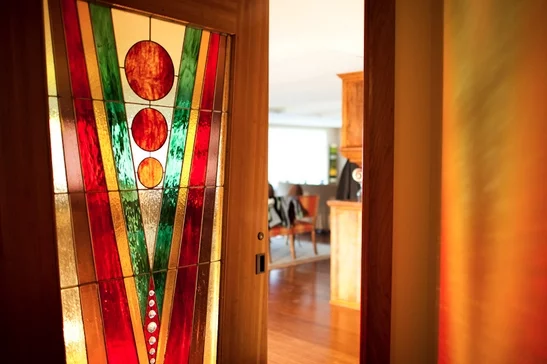
If you're interested in a type of glass that will allow sunlight to spill into your home in a variety of lovely hues, and comes in a variety of beautiful designs, then choosing an exterior door with custom made stained glass might be the right choice for you.
It is fine, delicate, and has limitless design options. On the other hand, it is often thin, energy inefficient, and less than secure.
If someone wanted to get into your home, they would have no trouble breaking through stained glass like in the exterior door above.
When choosing stained glass, you're definitely going for appearance over security or cost efficiency, texture
Laminated Glass
Laminated glass for your exterior door, AKA tempered glass, AKA toughened glass, AKA impact resistant or security glass, is the kind of glass you'll want if you want maximum security for your exterior door.
This thermally treated glass is the kind of glass they make car windshields from and when it breaks, it crumbles due to the way it has been made. Its a lot stronger than regular glass, and has all sorts of applications.
When applied to doors, its going to provide a lot more security than regular glass.
Here's a (very) quick video showing how this glass reacts in the event of some natural disaster.
Decorative Glass
Decorative glass is of course rather costly since it often features detailed designs which add a lot of beauty to your exterior door.
At the same time, decorative glass also adds some privacy as it is difficult to see inside unless you are up close. This depends, obviously, on the design and how it affects the glass.
And so concludes our lengthy discussion about exterior doors.
We hope this article has helped you in some way towards choosing the right exterior door for your home.
Please leave a comment if you like. We'd love to hear from you! Thanks for reading!
Related posts:
We Review 8 Of The Best Door & Window Sensors
Tips on How To Make Your Doors More Burglar Proof
What is a Deadbolt and How Does it Work?
 |
 |
 |
 |

About Robert Fox
Rob Fox is a former hydro worker who used to teach self defence in Miami for 10 years. He's currently enjoying his retirement, playing cribbage and golf with his buddies, locksmithing and home security in his spare time. Rob is an avid reader, and has even written a few books on the subject of self defence.
Thoughts on "Residential Exterior Doors – Your Complete Buying Guide"
 |
 |
 |
 |
You can Get FREE Gifts. Furthermore, Free Items here. Disable Ad Blocker to receive them all.
Once done, hit anything below
 |
 |
 |
 |